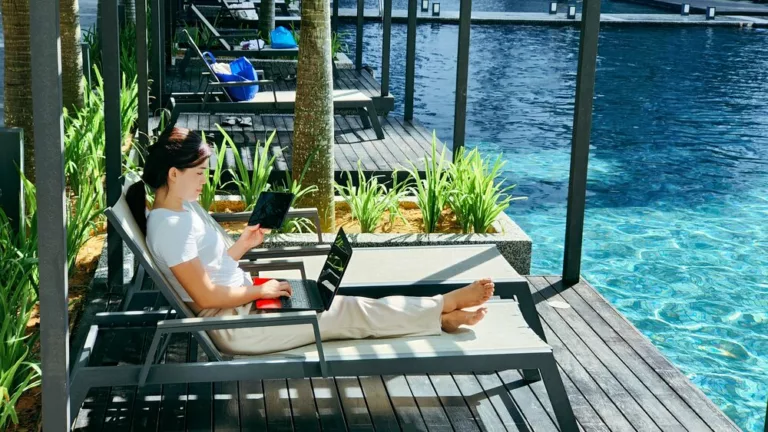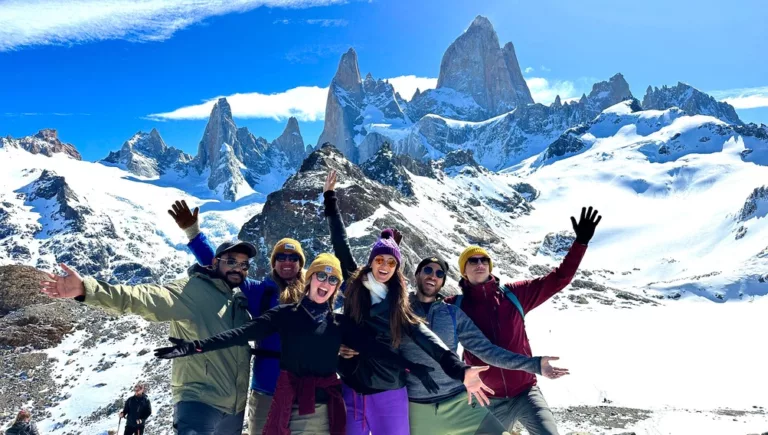Okay. Let’s start with a question. Close your eyes and imagine “creativity at work.”
Now open.
Did you see stock photos of hallways conversations, post-it notes, and whiteboards filled with diagrams straight out of Goodwill Hunting?
As you likely already know, there’s nothing particularly magical about hallways and dry-erase markers, especially for digital nomads. Those spaces represent creativity at work precisely for what they are not: they are spaces where things haven’t been decided yet, non-linear thoughts are permitted, and people can lower their guard to focus less on performance and perfection.
As current and former digital nomads, we’ve challenged the assumption that creativity is born at the water cooler, which led us to try living and working differently on our first Hacker Paradise (HP) trip to Cape Town in 2017. We’d been nomadic for a while and loved finding others who had embraced the freedom of WFA. We used timezone hacks for long morning hikes up Table Mountain before work and put holds in our calendars for weekly HP lunches with new friends.
Living without a strict 9-to-5, sit-in-one-place structure naturally builds one’s autonomy, self-reliance, prioritization, and problem-solving… but we were surprised to find it made something else: creativity.

After discussing our experiences, we realized that travel spurs creative thought for the same reason as those whiteboards and water coolers: it allows for the unknown. For Tam, travel jolts her out of her routines and complacency; suddenly, she has to navigate streets she’s never seen and languages she does not speak. Like a child, she has to learn anew—no longer can she run on autopilot. It’s like her brain is shouting, “Be present! Pay attention!” It’s then that she can finally enter into a beginner’s mindset.
What is a beginner’s mindset, and what does it have to do with creativity?
A beginner’s mindset, also known as “shoshin” or the beginner’s mind by Zen Buddhists, is one that always sees the world through new eyes. There are no comparisons, assumptions, or preconceived steps to achieve your goal. It’s a blank slate.
It’s counter-cultural to how we often approach life, where we’re rewarded for always having the right answer fast and off to the next item on our to-do list. In this atmosphere, though, creativity does not have room to breathe. It takes a backseat to busyness disguised as productivity.
Embracing a beginner’s mindset gives you the space to build afresh and the freedom to be creative. It’s okay to be wrong or wacky; it’s a part of the process. Creativity comes from letting go—of expectations of yourself and the outcome of your endeavor.

How travel puts us in a beginner’s mindset?
Ali still remembers a rookie travel mistake she made on one of her first trips as a digital nomad. She’d planned a solo day trip outside of the city but failed to notice the use of military times when booking her bus ticket. (Yep, she’s American.) Her bus arrived at 8 AM, and her departure was scheduled for 7 AM—which had already left the station.
Quick on her feet, Ali realized that it was logistically impossible and that she needed a new return ticket, pronto. She navigated the situation using her best beginner’s Spanish, a patient attitude, and a touch of humor.
When traveling, you’re constantly taking in new stimuli that test your preconditioned way of thinking and put you in a beginner’s mindset. Suddenly, you see how the barista grinds coffee or that the typography on the street signs looks different than at home. Walking along the beach, you can hear the fluctuation in sound as the waves crash along the shore and how the water changes from turquoise to indigo based on the ocean’s depth and the sun’s angle.
In a new environment, thinking from a fresh perspective and embracing the first principles of a beginner’s mindset is easier.

How can we bring the “beginner’s mindset” to remote work?
While travel is one way to enter a beginner’s mindset, it’s not always economically or physically feasible to join a Zoom call from a cafe in Buenos Aires or a coworking space on a Thai beach. However, you can use “remote work state of mind” as a creativity hack—whether in an office, park, or kitchen table, with people, or by yourself. It’s a mental state, not a geographic one.
Some Tips to Get Started:
1. Notice the small details: Be mindful. Pay attention to the minutia during your daily activities. Take note of people’s clothing and body language if you work from a cafe or coworking space. Observe plants, buildings, and street signs on your commute. Snap a photo if it helps you stay present. What ideas come to mind as you get lost in the details? What links can you draw between your daydreams and your tasks at work?
2. Change your routine: Break out of your 9-to-5 work routine (at least occasionally). You’ll likely be surprised by the fresh ideas that emerge after pushing yourself outside your comfort zone. If you find being creative when you first wake up challenging, how about working on more innovative tasks in the evening instead? You can learn more about your natural peaks and valleys for productivity and creativity using our RW Energy Tracker, available on our website and further explained in our book, Remote Works.
3. Learn from others: Inspiration can come from people, not just places. When Tam worked at IDEO, they often interviewed and observed analogous experts for design ideas. For example, she saw a magic show to learn more about play and took a Soul Cycle class for inspiration on community. When working with new people, take the time to learn about their working style. You can use our RW Collaboration Kickoff template to ask questions about communication preferences, preferred working hours, and more. Do you hear anything new? Why not try adapting to your coworker’s or client’s way of thinking? You might be surprised by the results.

Want to learn more about Remote Works? Follow @remoteworksbook on LinkedIn or visit www.remoteworksbook.com for more information on all things remote-work related.
You can also check out Ali and Tam’s upcoming book Remote Works: Managing for Freedom, Flexibility, and Focus available on Feb 7, 2023







